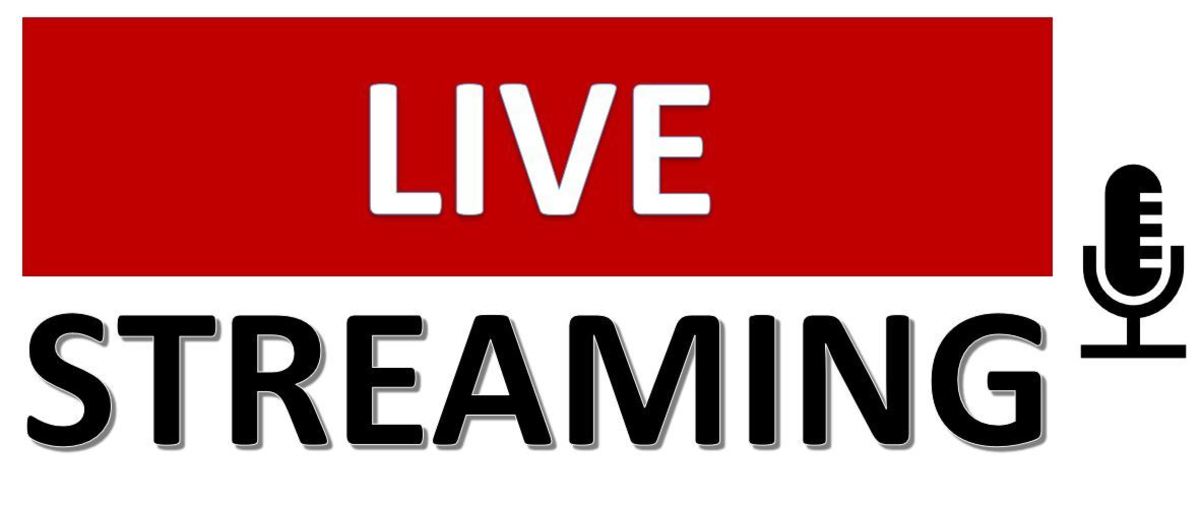Guide to Securing Sponsorship and Preparing a Sponsorship Proposal for Nonprofits

A sponsorship is a business arrangement that must meet certain corporate marketing objectives, provide a return on investment and be mutually beneficial to both parties. Sponsorship is a highly competitive area that requires strategic thinking, planning and execution. To increase the chances of securing sponsorship, it is important to consider what makes your event/programme worth sponsoring:
- Does the cause you support or the message you are conveying resonate strongly with the wider community?
- Are there going to be any notable guests attending?
- Will it attract media coverage?
- Is it an innovative event?
What sponsors generally look for in an event?
- An event that enhances their reputation as a conscientious and caring corporate citizen
- An opportunity to build relations with clients, employees, key stakeholders and the community
- Networking opportunities with customers, key stakeholders and the general public
- An event that reflects their philosophies and promotes their corporate vision and strategies
- Branding, marketing, media and PR opportunities
- Exclusivity (they are the only company from their sector/industry associated with the event)
- An opportunity to give back to the community
*Sponsors don’t need to have the same level of passion to the cause as you do, but there must be a commercial benefit which needs to be explicitly stated in your proposal.
Preparing a sponsorship plan
Prior to preparing a sponsorship proposal or package, develop a sponsorship plan. The plan will help identify what your needs are, what you can offer to potential sponsors and the types of companies to approach.
What to include in your plan
List Your Organisational Objectives & Assets
- Mission, aim and objectives of your organisation
- Organisational standing in the community
- Types of programs, activities and events offered
- Membership demographics
- Business networks
- Skills and expertise of staff and volunteers
- Print and media assets
List the Event Particulars
- Mission of the particular event
- The target group for the event
- Location and date
- Estimated attendance figures
- Cost of running the event
- Supplies and services required
- What can you provide in terms of volunteers, money, supplies and services etc…?
- What you need in terms of volunteers, money, supplies and services etc…?
List What You Can Give
Determine what you can offer potential sponsors in exchange for your sponsorship request; print and online exposure, television and radio exposure, naming rights, hospitality, signage, staff engagement, opportunity to promote products or services etc…
Finding Potential Sponsors
- List all businesses you currently deal with and all your members and supporters
- Network where possible. Attend events or informal gatherings as this will be an opportunity to build relations with local business people and ask them about their sponsorship policies or if they would be interested in supporting an event such as yours. This is a good way of soliciting new companies who have never thought about sponsorship.
- Given the theme of your event, conduct a yellow pages search for companies that correlate with the theme
- List businesses you are aware of that support similar organisations to yours or that have supported similar events in the past
- How many sponsors are you aiming for? Could one sponsor cover all your needs?
- Do any of your potential sponsors have an annual sponsorship budget?
Research Potential Companies
To narrow down the list of potential sponsors, think how closely they match with the objectives of the event/programme. Consider their philosophy and corporate vision and strategies; their corporate goals in terms of customer relations, image and reputation enhancement and publicity; their target market; the types of products and services they provide; and their advertising strategy.
In the case of larger companies, the majority of this information is available on their website; peruse through their annual and sustainability reports and newsletters. For small local companies, this information is probably best obtained through networking, informal gatherings or arranging face to face meetings.
Preparing the Sponsorship Proposal
Once suitable sponsors have been identified, you are now ready to prepare a letter or proposal. For small events, a brief letter should suffice and for larger events, you can a sponsorship proposal outlining different levels/tiers of sponsorship i.e. what the sponsor will get for sponsoring at the $500, $1,000 or $2,000 level. Many larger organisations have annual sponsorship budgets and have a sponsorship application form available on their website.
Writing the Letter (for small events)
Briefly explain your event, your request (be clear about this) and sponsorship benefits (tangible and intangible). The overall aim is to solicit a face to face meeting. You can also attach a nomination for sponsorship form to the letter – you never know, someone may want to give.
Developing the Sponsorship Package (for larger events with different sponsorship levels)
Prepare a cover letter
Keep it brief; thank them for considering the proposal and mention that you have the detailed proposal attached.
The proposal
Background
Provide a background explanation for your event i.e. how the event came about, examples of past success (this will give the potential sponsor confidence that you have the ability to manage such an event) etc... Include information from news clippings, photos or testimonials from past participants.
Description of the event
Describe the event in detail – date, day, times, location, expected attendance figures (compare to last year if you wish), target audience and demographics, activities to be undertaken, evaluation methods.
Sponsorship Investment
Outline of what you are requesting from the sponsor i.e. cash, product, prizes, services or expertise. Always include a price and make sure that sponsors at the higher sponsorship tiers get a better deal. Be realistic about costs and what it will take to make a profit and make sure what you’re asking for equates to the benefits you are offering.
Sponsorship Benefits
Outline all opportunities and tangible and intangible benefits. Wherever possible, quantify returns e.g. equivalent to paid advertising. For more ideas on what benefits you can offer potential sponsors, visit www.cuttingedgepr.com/articles/sponsorship_many_benefits.asp
Deadline
State a deadline and provide your contact details. Follow up by phone if you haven’t received a response after 10 days and offer to meet to discuss the proposal further if they are interested.
Nomination for Sponsorship Form
Include this at the end of the proposal.
Appendices – Add anything supporting documentation to enhance your application; letters of support, photos, newspaper clippings etc...
Follow up
Wait a week or ten days. If successful, arrange a meeting, make presentations, negotiate terms, clarify programs and draw up a sponsorship agreement. The sponsorship agreement can be in the form of a simple letter or for anything over $5000, a written document outlining what is expected of both parties is recommended.
Examples of sponsorship agreements:
Pointers
Prepare proposal well in advance of the event as sponsors need time to review their proposals and make their decisions. Allow three to twelve months depending on the size of the event.
Be flexible and try to accommodate the potential sponsor’s specific needs – the proposal that you initially came up with may be different to the one that you will sign up on.
Keep the proposal to 5-6 pages.
Proposals for exclusive sponsorship should not be sent to two companies simultaneously, especially for companies in the same industry. You want to avoid the scenario of both companies accepting your proposal.
Discuss sponsorship measurement with the sponsor early in the negotiation process to help clarify their marketing objectives and how you can help them achieve it. It is not your responsibility to measure the sponsor’s returns against their objectives and from their benchmarks. But you can report whether you delivered on the benefits you promised and things such as exposure i.e. website clicks or attendance figures – sponsors can then use this information to determine their return on investment. For further information, read this article on what a sponsee should include in a year-end ROI report blog.powersponsorship.com/index.php/2010/04/year-end-roi-report/
Example of a simple sponsorship letter
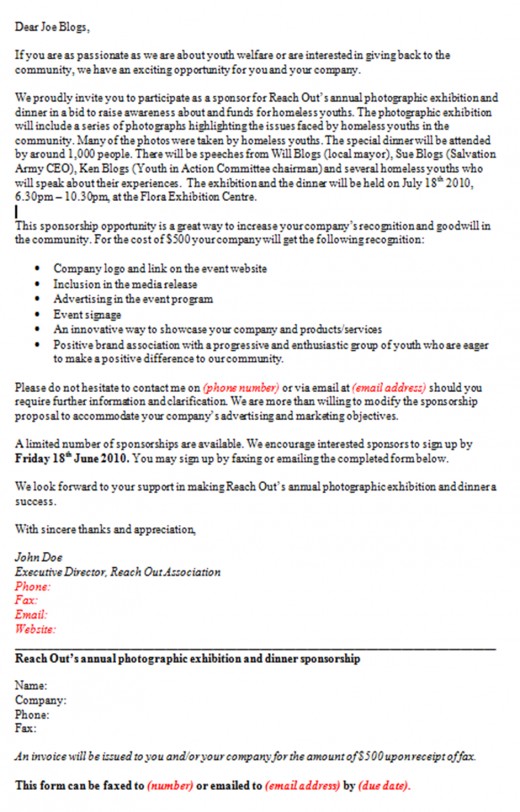
Example of a sponsorship package
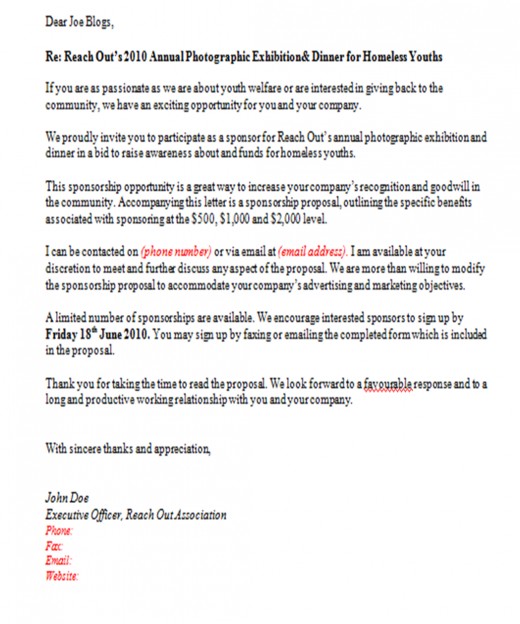
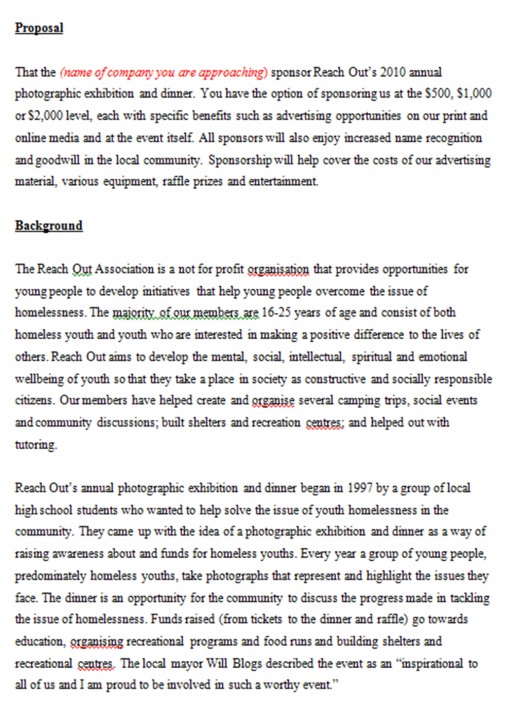
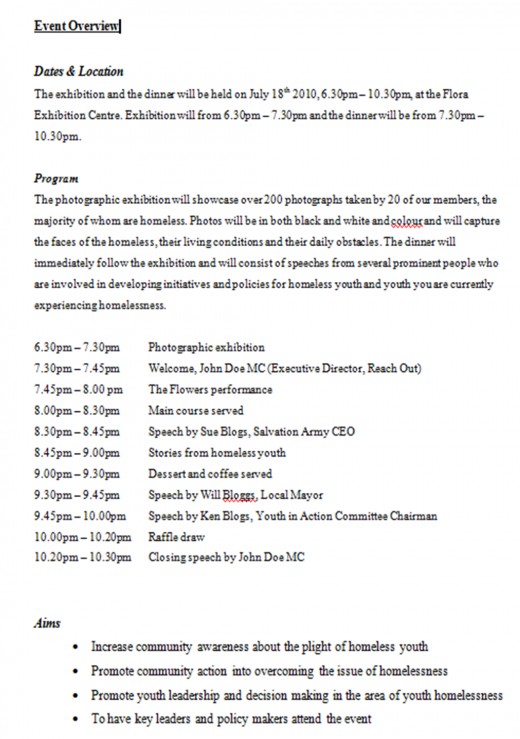
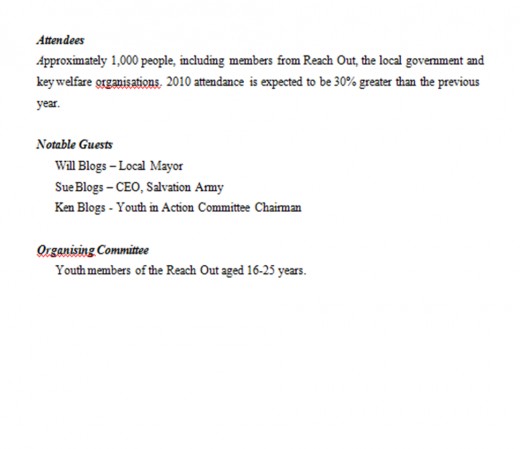
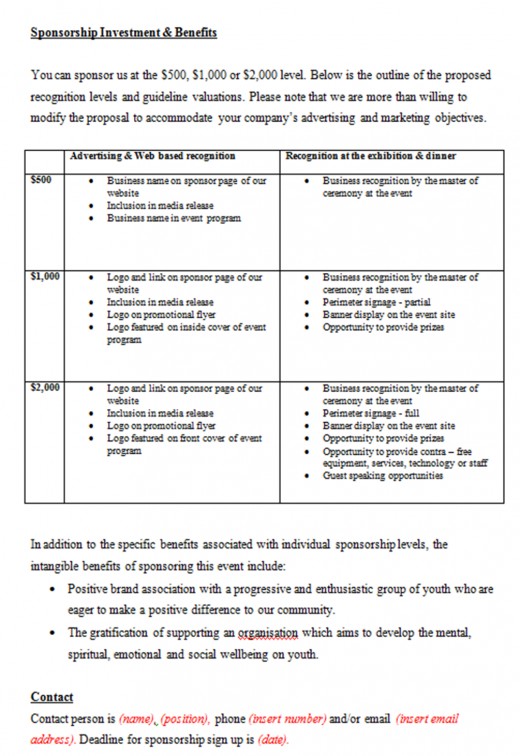
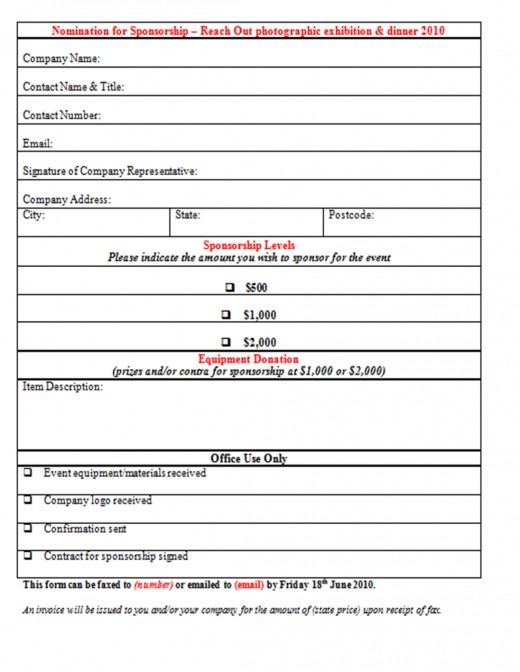
For further reading and more examples of sponsorship, please view http://fulltext.ausport.gov.au/fulltext/1997/hillary/rs5.pdf



